An infected tattoo can be caused by staph infections or MRSA, tainted manufacturer’s ink, an infected piercing etc. Signs and symptoms of tattoo infection may include scabs, pimples, oozing or draining pus, bleeding, blisters, damaged tattoo, peeling, fever rash and even redness. Here are images and how to treat an infected tattoo with medical treatments and home remedies.
Infected tattoo images, pictures or what does it look like
What does it mean when your tattoo gets an infection? What does an infected tattoo look like? Normally, tattoos may feel a bit uncomfortable for a few hours or even days when still fresh. However, the discomfort on your skin should go away quickly and on its own. Before seeing images of tattoos that are infected, you may not know how to identify a developing infection.
Below, we have included images and pictures to help you identify an abnormally healing tattoo after laser, peels, pimples, and scabs on the tattoos. The images show the symptoms that will point to an infection on your tattoo marks.
Causes of tattoo infection
What causes a new tattoo to heal badly? The cause will determine the type of problem you will experience on your skin. Some people complain of inflammation or redness on their ink-marks while others can complain of green pus. Some tattoo infections heal or won’t go away even after two weeks and can last for months. Here are the various causes of tattoo infections you should consider before visiting the studio for body art.
Tainted ink or contaminated black ink
It has been in the public domain for a long time now that infections on many people’s tattoos is traced to manufacturer’s ink. In the summer of 2012, the FDA warned that contaminated tattoo ink supplied by the manufacturer. This could be black ink or even white ink.
The contamination, according to the FDA is risky and includes fungi, mold, and bacteria. It is not a new thing, therefore, for patients to be diagnosed with bacterial infections and other ailments such as nontuberculous Mycobacteria, Hepatitis C etc. Symptoms you may experience include small bumps around tattoos, itchy skin, allergic reactions, white spots and pimples and more sings we have listed below.
Unsterilized tattooing equipment
While contamination of ink pigment and water used to dilute the ink are reported in new inks these days, poor hygiene is also a major cause of infections on tattoos. The tools your artist uses should be clean to prevent introducing bacteria and other pathogens under your skin. The bacteria can grow and make the healing time of your tattoo longer.
Staph infection tattoo and MRSA
Staph infections are also common on fresh tattoos and may start showing signs as soon as after 2 days. It is possible that you are getting a Methicillin-Resistant Staphylococcus aureus (MRSA) from tattoos. According to the WebMD, “staph infection has been reported among unlicensed tattoo artists in at least three states…”
MRSA is known to be a drug-resistant form of staphylococcus bacteria and can start eating your skin away within a short time. You can recognize MRSA staph infection on tattoo through the following symptoms.
- Folliculitis or small red bumps on the tattoo that won’t heal even with antibiotics treatment
- Large boils and painful blisters. These may form pus that will appear as either green or yellow. These boils may heal but they recur especially if caused by MRSA.
- Necrotizing fasciitis or an infection from tattoos that will eat away the skin following the layer between muscle and the skin.
These signs of an infected tattoo may remain before and after healing since antibiotic treatments are reported not to be effective in clearing the bacterium.
Poor tattoo aftercare practices
They are supposed to be kept clean, well aerated and free from bruising or disturbance. Failure to clean tattoos, no free air passage on the tattoo and abrasive irritation of the tattoos can easily cause an infection to develop. Most affected ones are tattoos on the back, chest, calf, eyebrow, knee, knuckle, lip, and foot.
Infection on tattoo after laser removal
Have you tried to remove your tattoo recently? When done the right way, laser tattoo removal should only have temporary side effects (according to SniperInk). However, signs of a fresh infection from laser removal include the following:
- Redness and swelling after laser treatment.
- Formation of crusts or scabs on the removed tattoo.
- Crusts, zits and rashes may last from 3 days to 2 weeks.
- Ultimately, you could easily end up with scars.
These infections or sepsis can also emerge if you have a piercing on top of the tattoo. An infected piercing, for example, can spread to the tattooed area. Blood poisoning can also result from the area, which can be risky for breastfeeding women and during pregnancy.
Infected tattoo symptoms and signs
When you know how to tell a tattoo is infected, you can quickly and easily start the treatment process or remedies to heal it fast before the infection spreads. You should be keen on symptoms such as bumps, abscesses, bleeding, pus drainage, blisters and sometimes fever. We have discussed these infected tattoo symptoms and signs below.
1. Scabs on infected back tattoos
A scabbing tattoo is definitely in the process of to healing from an infection. The formation of scabs helps the infected tissue under the skin to heal. The scabs prevent bleeding and oozing, which can keep the wound fresh and slow down the healing process.
If your tattoo is infected and, avoid picking the scabs since doing so is like causing new injury to the tattoo. Also, picking them will spread the infection to other parts of the body.
Though scabs are a sign of an infection, you should not consider them entirely so. Other signs of an infected tattoo should include constant discharge of fluid, redness, warmth and painful to touch.
2. Pimples and bumps on tattoos
Another sign of infection is a pimple or a bump, or something that looks like a zit on your tattoo. The American Academy of Dermatology says that rashes and bumps are symptoms of complications from tattoo ink. It is highly unlikely for people to get pimples on new body art, but if there’s a problem on it, you are likely to get bumps, rashes and pimples.
If you get a pimple, make sure you do not pick or scratch it. Scratching will damage the ink and ruin your tattoo. Acne pimples can also recur if your skin is acne-prone, so try not to pick on the zits that form.
3. Bleeding, pus discharge or oozing green pus
Is your body art draining green pus or oozing a yellow fluid? If, when cracked or cut open there’s fluid coming out, there are chances that there’s a problem.
Fresh tattoos may weep a little and produce a clear serum. This may have a few blood spots, but the tat should not bleed. If there’s excessive bleeding, you should see a doctor for treatment. Your doctor will help stop the bleeding. Most areas that are difficult to heal tattoos include the eyebrow, knee, knuckle, lip, foot. Sometimes, back and chest tattoos are difficult to heal and may bleed a little more because of the disturbance from clothing.
4. Abscess and blisters on tattoos
Blisters and things like an abscess are a clear indication of a severe infection. A tattoo abscess on the back can cause a lot of discomforts and even prevent you from wearing clothes especially if it gets bruised and bursts.
According to the Harvard Health Publications, blisters and tattoo abscess are warning signs of Mycobacterium bacteria. These bugs can grow fast and cause “mild rash around the tattoo site to severe abscesses…” Such will require surgery to treat and use of antibiotic therapy for several months.
5. Your tattoo peeling off or getting ruined
When your tattoo starts to peel, it is likely to start losing color. After a few months, it will be less visible as it was when fresh. So, what causes peeling and flaking?
It is normal for tattoos to peel off as dead skin is gotten rid of. The flakes may have some ink. That is why you are likely to see black peels from the area. However if the peeling continues even after it heals, it could point to a tattoo infection that can be threatening to damage your body art.
6. Swelling, inflammation, and redness on tattoo infection
Inflammation shows symptoms and signs such as redness, swelling or even itchy feeling. Irritation alone is not a symptom of an infected tattoo. LovetoKnow, advise that you place a clean hand over the tattooed area to feel if it is warmer than the rest of the body.
Redness and inflammation that lasts for over 48 hours is an indication of a growing infection. In addition, when the swelling spreads, it is a sign that the bacteria or microbes that are causing the disease are spreading and will need treatment, otherwise, the tattoo will get damaged.
7. Rash, cysts, and granulomas
If you get a rash or small cysts and granulomas on your tattoo, you could be reacting to the ink pigment that was used to draw the art. Granulomas and such rashes are the most common type of reaction to tattoo ink pigment, whether black, white, red, purple ink or any other color.
Granulomatous reactions are very common on tattoos made using blue ink more than other colors. The rashes form within the tattoo and can appear as cysts. Infections that come from these reactions may not be immediate on a fresh tattoo but may appear long after the tattoo has healed. [Dermadoctor.com]
8. Bad smell from tattoo
When the infection is caused by bad bacteria or anaerobic bacteria, your tattoo is likely to produce a bad smell. Green pus my show an advancing disease that is eating away tissue and should not be ignored because soon enough, it will start to be stinky. The discharge will worsen the situation
9. Pain and fever signs of infected tattoos
Pain and fever are two main signs of an underlying condition that keeps developing. If you have a fresh tattoo and you keep getting a fever and feeling pain on it, these are likely to be signs and symptoms of an infection on your tattoo.
A fresh tattoo may ache or hurt a little, but when the pain remains persistent after two to three days, it could be an indication of a developing infection. One simple color tattoo may not have a lot of pain because the level of penetration is little. If the fever and pain keep increasing, the infection is likely to be increasing.
10. Itching tattoo
Another important sign of an infected tattoo is itchiness. Skin infections and allergic reactions to the black tattoo ink usually manifest as rashes and itchy skin. The itchy feeling usually goes away on its own after a few days. However, if it lasts longer and increases its intensity, it is a sign of an infection that is underway.
How to treat an infected tattoo
Infections can be life-threatening if left untreated. MRSA staph is dangerous and spreads fast. Proper diagnosis and treatment of your tat infection is the first step towards healing an infected tattoo. If the infection is not very serious (like eating your skin away), you can rely on home remedies to fix a tattoo infection. If not, your doctor will prescribe medication for proper treatment. Here’s how to treat an infected tattoo with antibiotics and home remedies.
a) Prescription medications and treatments
Before doing anything, you should see a doctor if you think there is an infection. Some people advise that you see your tattoo artist or professional to help identify if there is any kind of reaction to the ink or any form of the disease is eating away the skin. Your physician is likely to prescribe antibiotics if he or she discovers you have an infection.
- Bacitracin and Neosporin: These are topical prescription treatments that are given if the tat is badly infected.
- Antibiotics such as amoxicillin, Doxycycline, and Fucidin may also be prescribed to help heal a tattoo infection. Amoxicillin is an oral antibiotic. If the infection persists after antibiotics, some intravenous injections of the medication may be given. This is usually done if the infection won’t go away.
- Your doctor may also prescribe an over the counter treatment such as Betadine. Dr. Kalpana Pathak recommends that you clean the area with betadine and apply a good topical antibiotic such as Mupirocin two times a day. [HealthcareMagic.com]
b) How to heal a tattoo infection with home remedies
If you want to treat your infection at home, you can use some home remedies too. Some people have recommended the use of hydrogen peroxide, honey and alcohol to get rid of bacteria and help the tattoo heal faster.
Hydrogen peroxide is a good home remedy for bacterial infections, but it can cause your skin to dry and crack. This does not help wounds on your tattoo. The scabs will crack and become painful. You don’t want your art itching and encouraging you to scratch it. Here are a few remedies to try at home if you have a mild infection on your tattoo.
Tea tree oil
Tea tree oil has antibacterial properties and will help get rid of most bacterial and even fungal infections. This oil will also help hydrate the skin. Keeping the area moist without adding water to it is also a good way to help it heal faster.
- Clean the tattoo well with antibacterial liquid soap.
- Pat dry using a clean towel. Do not rub off.
- Apply a thin layer of dilute tea tree oil and leave it overnight.
- Repeat until it heals.
Aloe Vera Gel
Aloe vera gel hydrates and works as an antibiotic as well. According to Beneath the Skin Tattoo website, it is a good home alternative to Bacitracin ointment.
- Apply aloe vera gel on a clean tattoo twice a day.
- Repeat until it heals.
When using home treatments, try to avoid ingredients that might remove your tattoo. These include baking soda and apple cider vinegar. Hydrogen peroxide also lightens skin and will fade tattoos so I would not advise that you put it on your art.
Infected tattoo care and aftercare
When the infection is not very serious, you can care for it at home and help it heal. Problems and symptoms such as swelling and inflammation can be reduced at home. Do not attempt to get rid of a tattoo infection at home if the infection is severe. Here are home infected tattoo care instructions and tips to follow.
- In case of minor bleeding, apply a little pressure on the area to stop. Stopping bleeding will help your wound clot and scab over, then start healing fast.
- If there is itching, apply a cold compress or a cold pack on the area. This will swelling, itching and bruising. Be careful not to apply ice directly onto your wound as this can lead to damage of tissue.
- To reduce exposure to dirt (which can cause infections), apply a bandage. You should choose a non-stick bandage to reduce the damage of tissue on the area with the infection when you remove it.
- Keep the tattoo dry all the time to avoid infections. If you are considering an infected tattoo care, avoid swimming or exposing it to water when taking a shower. Wetting it will only slow down the healing process.
- According to Search Body Art, wearing sunscreen when going into the sun will prevent sun exposure. Sun exposure will cause sun poisoning and make you prone to infections.
How to clean an infected tattoo
Other than knowing how to care for an infected tattoo, part of the care process is knowing how to clean it the right way to prevent, stop and treat an infection. Part of tattoo after-care tips concerning cleaning includes the following. So here’s what to do.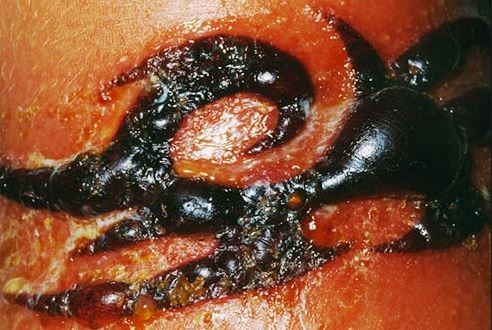
- Always clean your hands well before touching a tattoo that has an infection.
- If you have any bandage on the area, remove it after about 3 hours of dressing.
- Wipe and clean the tattoo using an anti-bacterial liquid soap to help get rid of the bacteria on the wound or abscess. Do not use a piece of cloth for cleaning because it will exfoliate the area.
- Pat the tattoo dry and do it gently to prevent bruising it.
After cleaning, always wear soft and clean clothing to allow your tattoo an ample environment to heal. Tight clothing will make it difficult for the skin to get fresh air. Anaerobic bacteria can easily grow on your tattoo making it smell bad. Also, avoid wearing materials that are abrasive, such as jewelry, shoes or tough clothing because they are likely to rub against the tattoo, making it difficult to heal.
Infected tattoo video
Here’s a video on infections on tattoos, aftercare and treatment.
Sources and references
- Medical Daily: FDA Warns That Tattoo Inks Are Causing Skin Infections
- WebMD: Tattoos Linked to Deadly (MRSA staph) Infection
- Mayo Clinic: MRSA infection symptoms
- SniperInk: Laser Tattoo Removal Side Effects
- Harvard Health Publications: Tattoos and infection: Think before you ink
- The American Academy of Dermatology: Dermatologist warns consumers about complications linked to newer tattoo inks
- The American Family Physician: Delayed Complication from a Tattoo
- Beneath the Skin Tattoo: TATTOO AFTERCARE

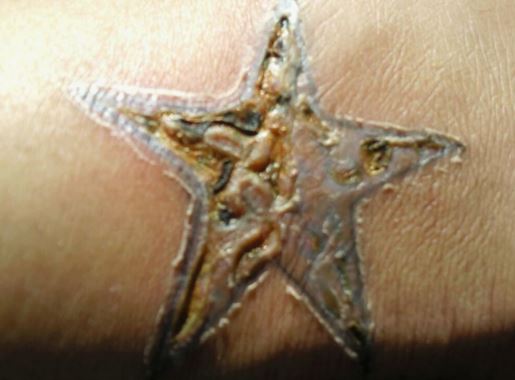
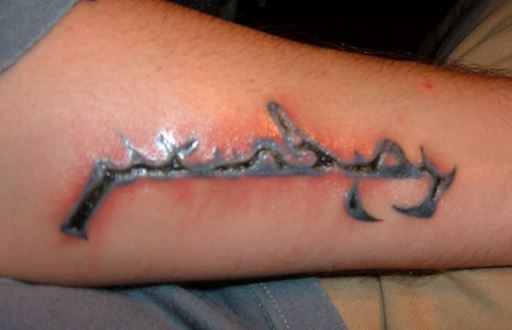
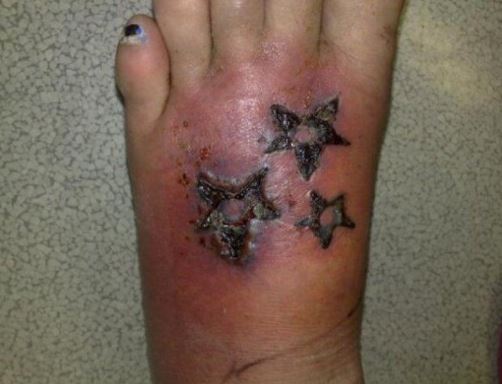
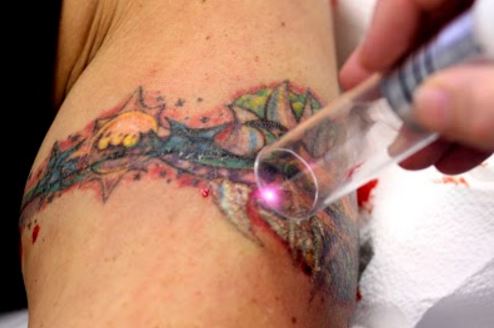
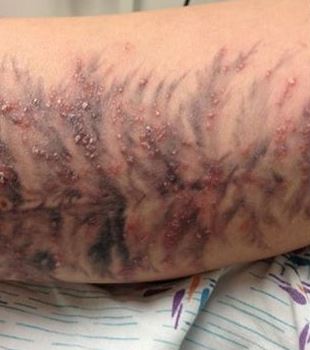
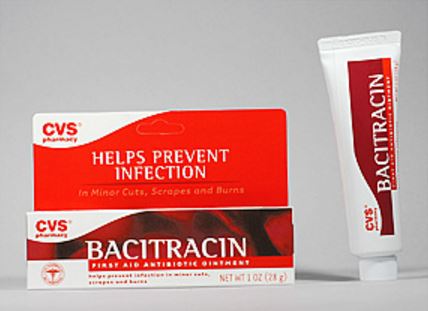
4 comments
Is that a grown mans arm? It’s so skinny. She almost wraps her hand all the way around it.
This article is so wrong it’s insane.. staph lives on every ones skin but only certain people actually get it. Mersa is a blood infection. None of this can be caused by bad ink. It’s caused by dirty needles and/or dirty hands, or skin. You should be clean and groomed when getting a tattoo as should your artist. They should also open a new needle in front of you as well as put on gloves. The worst bad ink can do is give you a bad infection, cause a major rash, and blister, or even eat a hole in your skin.
staph lives on all skin, MRSA (not ‘mersa’) is a category of drug-resistant staph that can cause bloodstream infections (which can lead to endocarditis or sepsis) as well as localized infections (abscess, cellulitis, necrotizing infection). sure, cleaning and fresh needles are preventive, but the only way to guarantee no infection from a tattoo is not to get a tattoo. And these infections can still happen just from infection of hair follicles, nasal passages, etc without a tattoo, so I’m not trying to be anti-tattoo.
Also, streptococcus species and other bacteria can cause cellulitis, abscess, and more, just they tend to be more easily treated with antibiotics. Skin is a barrier, and violating it for any reason (abrasion, cut, puncture) opens the possibility of infection.
That video was disgusting!